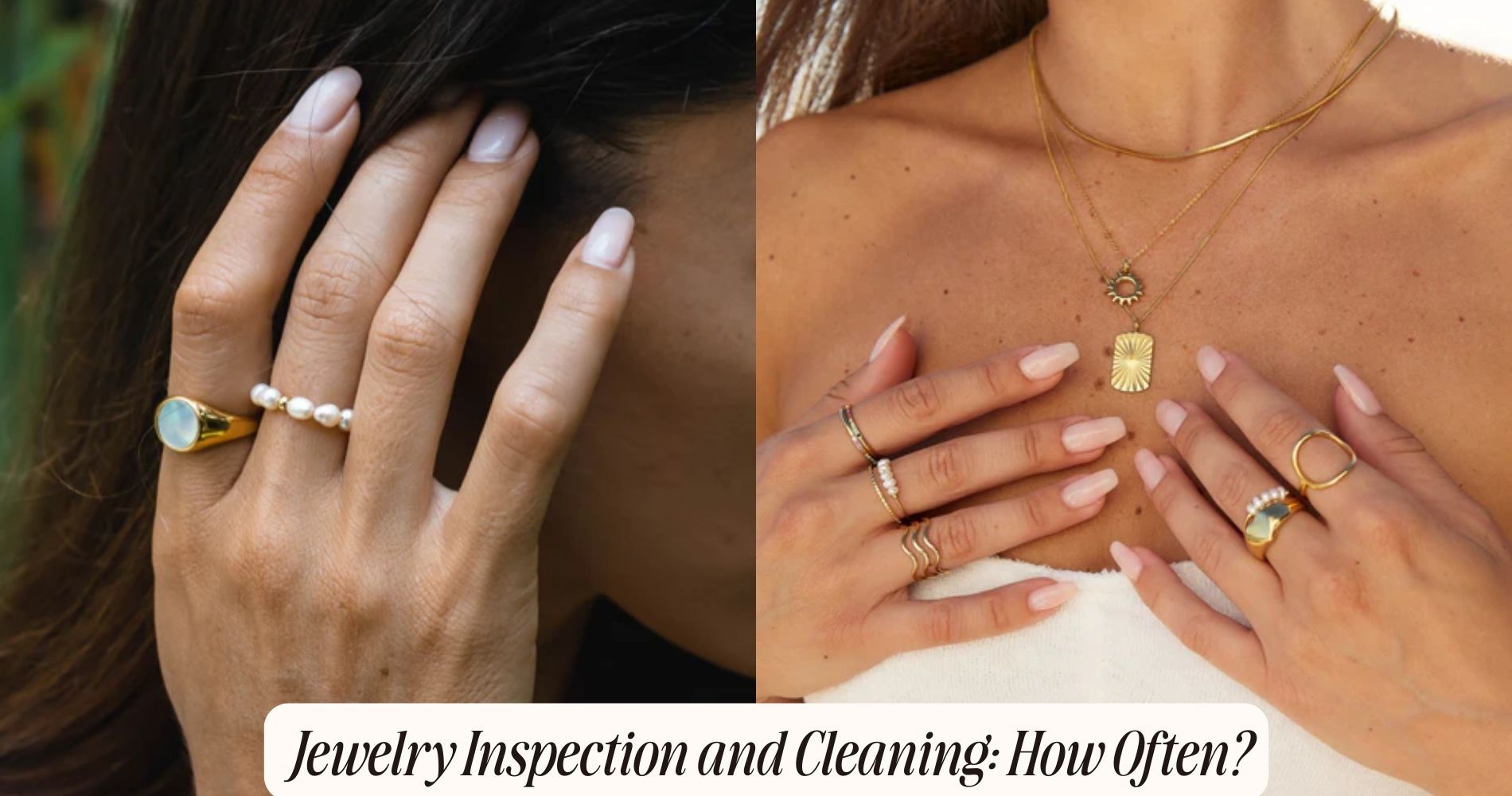
Jewelry Inspection and Cleaning: How Often?
To understand how often jewelry should be inspected and cleaned, it's important to follow a few best practices. Daily maintenance includes a gentle brushing to eliminate accumulated dirt and oils, complemented by the use of a premium polishing cloth. For a deeper clean, a mild soap solution once a month is recommended. However, be mindful when using ultrasonic cleaners, as they may not be suitable for softer gemstones. It's also crucial to have your jewelry professionally inspected every six months. These inspections can reveal structural issues and confirm the authenticity of your gemstones and metals, helping to preserve your jewelry over time.
Additionally, storing your pieces in a humidity-controlled environment can prevent tarnishing and degradation. For more comprehensive guidance, including detailed care practices, explore our Hypoallergenic Jewelry collection.
Understanding Jewelry Materials
Understanding the various materials used in jewelry is important because each type—whether gold, silver, platinum, or gemstones—requires specific care and maintenance techniques. Metal types like gold and silver are prone to tarnishing and scratching, necessitating different cleaning methods.
Gold, particularly 24-karat, is softer and more susceptible to damage compared to 14-karat or 18-karat gold, which are alloyed with other metals to enhance durability. Silver, while more affordable, oxidizes over time, requiring regular polishing. Platinum, a denser and more durable metal, resists tarnish but can still acquire scratches that need to be buffed out periodically.

Gemstone durability varies significantly. Diamonds, for instance, score a 10 on the Mohs hardness scale, making them extremely resistant to scratches but still vulnerable to chipping from hard impacts. Softer gemstones like pearls, opals, and turquoise, rank much lower and require gentler handling to prevent surface damage.
Understanding these material characteristics is essential for proper jewelry care. Each metal type and gemstone demands specific cleaning agents and techniques to maintain their luster and integrity. Incorrect handling or cleaning can irreversibly damage these precious items, reducing their longevity and aesthetic appeal.
Daily Maintenance Tips
To guarantee your jewelry retains its brilliance and value, incorporate daily maintenance practices tailored to each piece's material composition. Start by using a gentle brushing technique to remove surface dirt and oils that accumulate throughout the day. Utilize a soft-bristled brush, ideally one with natural fibers, to prevent scratching delicate surfaces.
For metal components, employ a high-quality polishing cloth designed specifically for jewelry. This helps to maintain luster and prevent tarnish. When polishing, apply light pressure and use circular motions to enhance the shine without causing abrasion.
Pay special attention to gemstones and settings. Make sure that prongs and bezels are free of debris, as buildup can weaken the structural integrity of the mountings. For softer stones like opals or pearls, avoid brushing and instead use a damp, lint-free cloth to gently wipe them clean.
It's important to handle your jewelry with care. Remove rings and bracelets before engaging in activities that could expose them to harsh chemicals or physical impact. Store each piece individually in a soft pouch or lined compartment to prevent scratches and tangling.
Monthly Cleaning Routine
Incorporating a monthly cleaning routine guarantees your jewelry remains in peak condition, addressing deeper grime and buildup that daily maintenance might miss.
Begin by evaluating the type of jewelry and gemstones you're cleaning, as some materials require specific care to prevent damage.
Home remedies like a mild soap solution can be effective for most metals and stones. Combine warm water with a few drops of mild dish soap, soak your jewelry for 15-20 minutes, and use a soft-bristled brush to gently scrub away any residual dirt.
Rinse thoroughly and pat dry with a lint-free cloth to avoid scratching.
For more intricate pieces or those with significant buildup, ultrasonic cleaners offer a more thorough cleaning. These devices use high-frequency sound waves to create microscopic bubbles that dislodge dirt and grime from even the most inaccessible crevices.
However, be cautious: ultrasonic cleaners aren't suitable for all gemstones, particularly softer ones like pearls or opals, which can be damaged by the intense vibrations.
Professional Inspections
A professional jeweler's examination guarantees your pieces are structurally sound, identifying issues like loose settings or worn prongs that home cleaning might overlook. This level of scrutiny involves a meticulous damage assessment, ensuring the integrity of each component. Jewelers use magnification tools, such as loupes or microscopes, to inspect for micro-fractures and other potential vulnerabilities that could compromise the piece over time.
During a professional inspection, the jeweler will also verify the authenticity of gemstones and metals through a certification process. This process includes checking for hallmark stamps, conducting tests to confirm the metal type, and evaluating the quality of gemstones. Accurate certification bolsters the value of your jewelry and provides peace of mind regarding its authenticity.
Professional inspections should occur biannually to maintain peak condition and to catch any issues early before they escalate into costly repairs. By entrusting your pieces to an experienced jeweler, you're ensuring that any minor imperfections are promptly and expertly addressed. This proactive approach not only extends the life of your jewelry but also preserves its aesthetic and financial value, making it an essential part of your maintenance routine.
Storing Your Jewelry Properly
Properly storing your jewelry is essential for preventing damage, minimizing wear, and preserving its brilliance. Begin by considering humidity control. Excessive moisture can tarnish metals and degrade the structural integrity of delicate pieces. Use silica gel packets or activated charcoal in your storage area to absorb ambient moisture. These desiccants are vital for maintaining an ideal environment.
Airtight storage solutions, such as zip-lock bags or vacuum-sealed containers, are excellent for reducing exposure to air and humidity. They help prevent oxidation and corrosion, especially for silver and other reactive metals.
For high-value items, invest in a professional-grade jewelry box with distinct compartments and cushioned interiors. This prevents pieces from scratching each other. Ensure each piece is stored separately. Use soft pouches or individual cloth bags to avoid tangling and abrasion.
For necklaces, hang them vertically to prevent kinking and knotting. Pearls require special care; keep them in breathable fabric to maintain their luster and avoid airtight storage, as they need some humidity.
Regularly inspect your storage setup. Look for signs of moisture build-up or physical wear. By implementing these strategies, you'll extend the life and beauty of your cherished pieces.
Frequently Asked Questions
How Can I Tell if My Jewelry Needs a Deep Cleaning?
To determine if your jewelry needs a deep cleaning, examine the gemstone clarity and check for metal discoloration. If the gemstones appear cloudy or the metal looks tarnished, it's time for a thorough cleaning.
Are Ultrasonic Cleaners Safe for All Types of Jewelry?
Ultrasonic cleaners aren't safe for all jewelry types. High ultrasonic frequency can damage delicate stones like opals, emeralds, and pearls. Always check your jewelry's material composition before using ultrasonic cleaning to avoid irreversible damage.
Can Homemade Cleaning Solutions Damage My Jewelry?
Homemade cleaning solutions can damage your jewelry through unwanted chemical reactions or abrasive ingredients. These can erode metal finishes or scratch gemstones, leading to irreversible harm. Always verify each ingredient's compatibility with your jewelry materials.
How Do I Remove Tarnish From Silver Jewelry?
To remove tarnish from silver jewelry, use chemical baths specifically designed for silver or polishing cloths impregnated with anti-tarnish agents. Always follow manufacturer instructions to avoid damaging your pieces during the cleaning process.
What Signs Indicate a Need for Immediate Professional Repair?
You should seek immediate professional repair if you notice loose stones or broken clasps. These issues can compromise the integrity and safety of your jewelry, requiring expert attention to prevent further damage or complete loss.
Conclusion
By following daily maintenance, monthly cleaning, and regular professional inspections, you'll preserve your jewelry's brilliance and longevity. Understand the nuances of different materials to tailor your care routine effectively. Proper storage mitigates risks of damage and tarnish.
Consistent care guarantees that your cherished pieces remain in top condition, showcasing their true beauty and craftsmanship. With these practices, your jewelry will continue to dazzle for years to come.






















Leave a comment
This site is protected by hCaptcha and the hCaptcha Privacy Policy and Terms of Service apply.